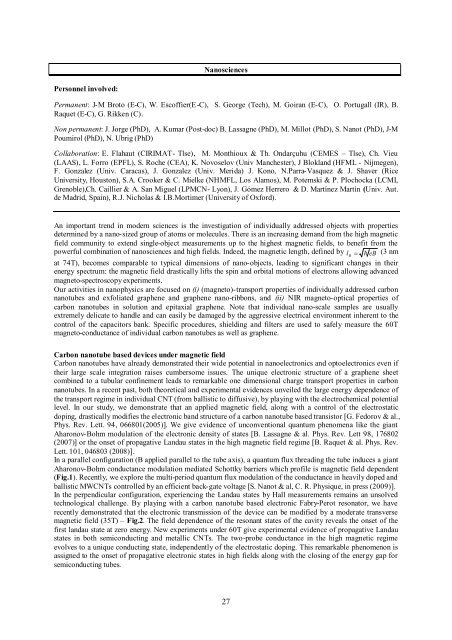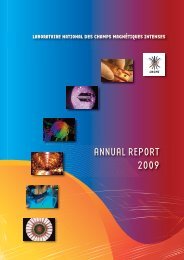Laboratoire National des Champs Magnétiques Pulsés CNRS – INSA
Laboratoire National des Champs Magnétiques Pulsés CNRS – INSA
Laboratoire National des Champs Magnétiques Pulsés CNRS – INSA
You also want an ePaper? Increase the reach of your titles
YUMPU automatically turns print PDFs into web optimized ePapers that Google loves.
Personnel involved:<br />
Nanosciences<br />
Permanent: J-M Broto (E-C), W. Escoffier(E-C), S. George (Tech), M. Goiran (E-C), O. Portugall (IR), B.<br />
Raquet (E-C), G. Rikken (C).<br />
Non permanent: J. Jorge (PhD), A. Kumar (Post-doc) B. Lassagne (PhD), M. Millot (PhD), S. Nanot (PhD), J-M<br />
Poumirol (PhD), N. Ubrig (PhD)<br />
Collaboration: E. Flahaut (CIRIMAT- Tlse), M. Monthioux & Th. Ondarçuhu (CEMES <strong>–</strong> Tlse), Ch. Vieu<br />
(LAAS), L. Forro (EPFL), S. Roche (CEA), K. Novoselov (Univ Manchester), J Blokland (HFML - Nijmegen),<br />
F. Gonzalez (Univ. Caracas), J. Gonzalez (Univ. Merida) J. Kono, N.Parra-Vasquez & J. Shaver (Rice<br />
University, Houston), S.A. Crooker & C. Mielke (NHMFL, Los Alamos), M. Potemski & P. Plochocka (LCMI,<br />
Grenoble),Ch. Caillier & A. San Miguel (LPMCN- Lyon), J. Gómez Herrero & D. Martínez Martín (Univ. Aut.<br />
de Madrid, Spain), R.J. Nicholas & I.B.Mortimer (University of Oxford).<br />
An important trend in modern sciences is the investigation of individually addressed objects with properties<br />
determined by a nano-sized group of atoms or molecules. There is an increasing demand from the high magnetic<br />
field community to extend single-object measurements up to the highest magnetic fields, to benefit from the<br />
powerful combination of nanosciences and high fields. Indeed, the magnetic length, defined by lB � �eB<br />
(3 nm<br />
at 74T), becomes comparable to typical dimensions of nano-objects, leading to significant changes in their<br />
energy spectrum: the magnetic field drastically lifts the spin and orbital motions of electrons allowing advanced<br />
magneto-spectroscopy experiments.<br />
Our activities in nanophysics are focused on (i) (magneto)-transport properties of individually addressed carbon<br />
nanotubes and exfoliated graphene and graphene nano-ribbons, and (ii) NIR magneto-optical properties of<br />
carbon nanotubes in solution and epitaxial graphene. Note that individual nano-scale samples are usually<br />
extremely delicate to handle and can easily be damaged by the aggressive electrical environment inherent to the<br />
control of the capacitors bank. Specific procedures, shielding and filters are used to safely measure the 60T<br />
magneto-conductance of individual carbon nanotubes as well as graphene.<br />
Carbon nanotube based devices under magnetic field<br />
Carbon nanotubes have already demonstrated their wide potential in nanoelectronics and optoelectronics even if<br />
their large scale integration raises cumbersome issues. The unique electronic structure of a graphene sheet<br />
combined to a tubular confinement leads to remarkable one dimensional charge transport properties in carbon<br />
nanotubes. In a recent past, both theoretical and experimental evidences unveiled the large energy dependence of<br />
the transport regime in individual CNT (from ballistic to diffusive), by playing with the electrochemical potential<br />
level. In our study, we demonstrate that an applied magnetic field, along with a control of the electrostatic<br />
doping, drastically modifies the electronic band structure of a carbon nanotube based transistor [G. Fedorov & al.,<br />
Phys. Rev. Lett. 94, 066801(2005)]. We give evidence of unconventional quantum phenomena like the giant<br />
Aharonov-Bohm modulation of the electronic density of states [B. Lassagne & al. Phys. Rev. Lett 98, 176802<br />
(2007)] or the onset of propagative Landau states in the high magnetic field regime [B. Raquet & al. Phys. Rev.<br />
Lett. 101, 046803 (2008)].<br />
In a parallel configuration (B applied parallel to the tube axis), a quantum flux threading the tube induces a giant<br />
Aharonov-Bohm conductance modulation mediated Schottky barriers which profile is magnetic field dependent<br />
(Fig.1). Recently, we explore the multi-period quantum flux modulation of the conductance in heavily doped and<br />
ballistic MWCNTs controlled by an efficient back-gate voltage [S. Nanot & al, C. R. Physique, in press (2009)].<br />
In the perpendicular configuration, experiencing the Landau states by Hall measurements remains an unsolved<br />
technological challenge. By playing with a carbon nanotube based electronic Fabry-Perot resonator, we have<br />
recently demonstrated that the electronic transmission of the device can be modified by a moderate transverse<br />
magnetic field (35T) <strong>–</strong> Fig.2. The field dependence of the resonant states of the cavity reveals the onset of the<br />
first landau state at zero energy. New experiments under 60T give experimental evidence of propagative Landau<br />
states in both semiconducting and metallic CNTs. The two-probe conductance in the high magnetic regime<br />
evolves to a unique conducting state, independently of the electrostatic doping. This remarkable phenomenon is<br />
assigned to the onset of propagative electronic states in high fields along with the closing of the energy gap for<br />
semiconducting tubes.<br />
27







